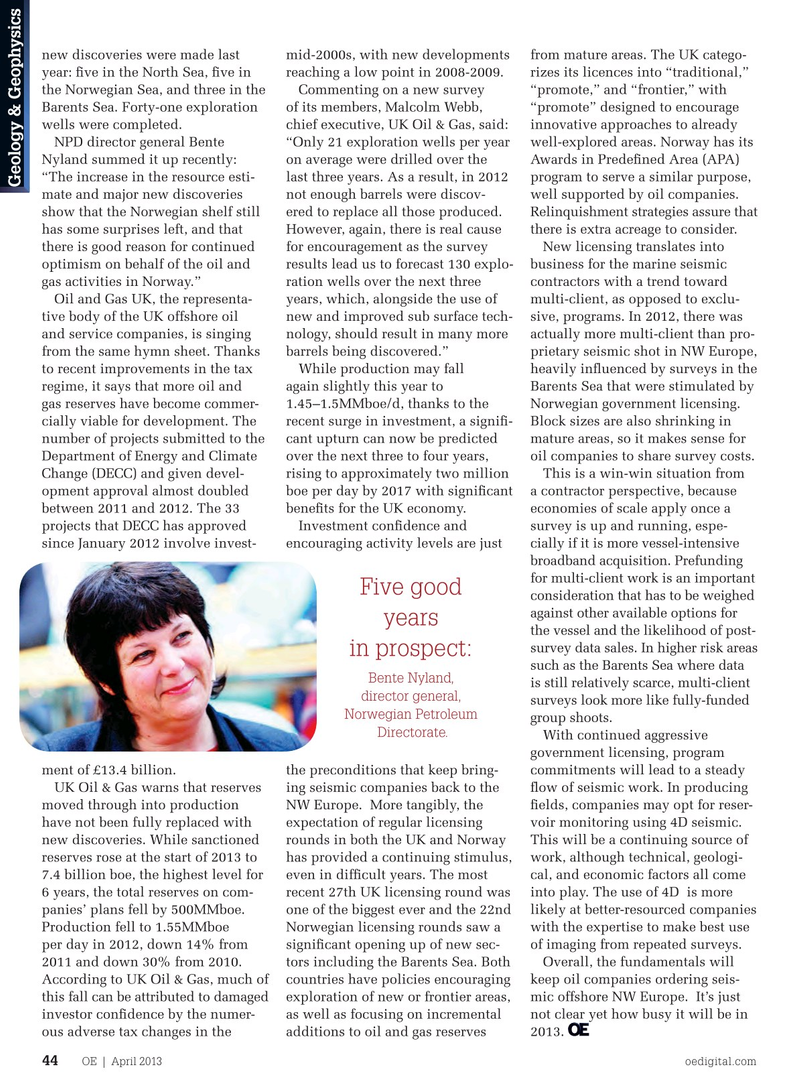
Page 42: of Offshore Engineer Magazine (Apr/May 2013)
Read this page in Pdf, Flash or Html5 edition of Apr/May 2013 Offshore Engineer Magazine
new discoveries were made last mid-2000s, with new developments from mature areas. The UK catego- year: fve in the North Sea, fve in reaching a low point in 2008-2009. rizes its licences into “traditional,” the Norwegian Sea, and three in the Commenting on a new survey “promote,” and “frontier,” with
Barents Sea. Forty-one exploration of its members, Malcolm Webb, “promote” designed to encourage wells were completed. chief executive, UK Oil & Gas, said: innovative approaches to already
NPD director general Bente “Only 21 exploration wells per year well-explored areas. Norway has its
Nyland summed it up recently: on average were drilled over the Awards in Predefned Area (APA) “The increase in the resource esti- last three years. As a result, in 2012 program to serve a similar purpose,
Geology & Geophysics mate and major new discoveries not enough barrels were discov- well supported by oil companies. show that the Norwegian shelf still ered to replace all those produced. Relinquishment strategies assure that has some surprises left, and that However, again, there is real cause there is extra acreage to consider.
there is good reason for continued for encouragement as the survey New licensing translates into optimism on behalf of the oil and results lead us to forecast 130 explo- business for the marine seismic gas activities in Norway.” ration wells over the next three contractors with a trend toward
Oil and Gas UK, the representa- years, which, alongside the use of multi-client, as opposed to exclu- tive body of the UK offshore oil new and improved sub surface tech- sive, programs. In 2012, there was and service companies, is singing nology, should result in many more actually more multi-client than pro- from the same hymn sheet. Thanks barrels being discovered.” prietary seismic shot in NW Europe, to recent improvements in the tax While production may fall heavily infuenced by surveys in the regime, it says that more oil and again slightly this year to Barents Sea that were stimulated by gas reserves have become commer- 1.45–1.5MMboe/d, thanks to the Norwegian government licensing. cially viable for development. The recent surge in investment, a signif- Block sizes are also shrinking in number of projects submitted to the cant upturn can now be predicted mature areas, so it makes sense for
Department of Energy and Climate over the next three to four years, oil companies to share survey costs.
Change (DECC) and given devel- rising to approximately two million This is a win-win situation from opment approval almost doubled boe per day by 2017 with signifcant a contractor perspective, because between 2011 and 2012. The 33 benefts for the UK economy. economies of scale apply once a projects that DECC has approved Investment confdence and survey is up and running, espe- since January 2012 involve invest- encouraging activity levels are just cially if it is more vessel-intensive broadband acquisition. Prefunding for multi-client work is an important
Five good consideration that has to be weighed against other available options for years the vessel and the likelihood of post- survey data sales. In higher risk areas in prospect: such as the Barents Sea where data
Bente Nyland, is still relatively scarce, multi-client director general, surveys look more like fully-funded
Norwegian Petroleum group shoots.
Directorate.
With continued aggressive government licensing, program the preconditions that keep bring- ment of £13.4 billion. commitments will lead to a steady ing seismic companies back to the UK Oil & Gas warns that reserves fow of seismic work. In producing
NW Europe. More tangibly, the moved through into production felds, companies may opt for reser- expectation of regular licensing have not been fully replaced with voir monitoring using 4D seismic. rounds in both the UK and Norway new discoveries. While sanctioned This will be a continuing source of has provided a continuing stimulus, reserves rose at the start of 2013 to work, although technical, geologi- even in diffcult years. The most 7.4 billion boe, the highest level for cal, and economic factors all come recent 27th UK licensing round was 6 years, the total reserves on com- into play. The use of 4D is more one of the biggest ever and the 22nd panies’ plans fell by 500MMboe. likely at better-resourced companies
Norwegian licensing rounds saw a Production fell to 1.55MMboe with the expertise to make best use signifcant opening up of new sec- per day in 2012, down 14% from of imaging from repeated surveys.
tors including the Barents Sea. Both 2011 and down 30% from 2010. Overall, the fundamentals will countries have policies encouraging According to UK Oil & Gas, much of keep oil companies ordering seis- this fall can be attributed to damaged exploration of new or frontier areas, mic offshore NW Europe. It’s just as well as focusing on incremental investor conf dence by the numer- not clear yet how busy it will be in additions to oil and gas reserves ous adverse tax changes in the 2013.
OE | April 2013 oedigital.com 44 oe_g_and_g.indd 44 4/1/13 3:48 PM

 41
41

 43
43